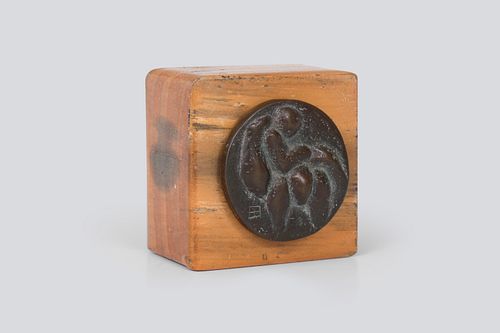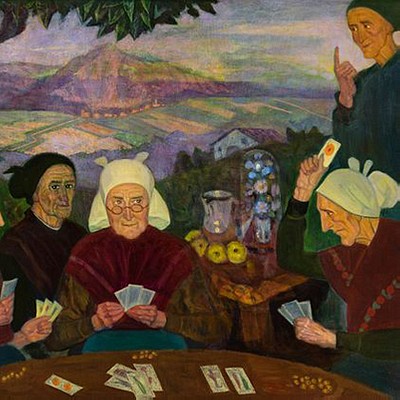EDUARDO CHILLIDA JUANTEGUI (San Sebastian, 1924 - 2002). "San Cristobal". Bronze relief.
Lot 59
About Seller
Setdart Auction House
Carrer Aragó 346
Barcelona
Spain
Setdart Subastas was born in 2004 and is currently the first online art auction in Spain with solidity, prestige and reliability guaranteed by our more than 60,000 users. Setdart has a young, dynamic and enterprising team ready to successfully manage the purchase and sale of art works through custom...Read more
Categories
Estimate:
EUR€3,500 - EUR€4,000
$3,763.44 - $4,301.08
Absentee vs Live bid
Two ways to bid:
- Leave a max absentee bid and the platform will bid on your behalf up to your maximum bid during the live auction.
- Bid live during the auction and your bids will be submitted real-time to the auctioneer.
Bid Increments
| Price | Bid Increment |
|---|---|
| EUR€0 | EUR€10 |
| EUR€200 | EUR€25 |
| EUR€500 | EUR€50 |
| EUR€1,000 | EUR€100 |
| EUR€3,000 | EUR€200 |
| EUR€5,000 | EUR€500 |
| EUR€10,000 | EUR€1,000 |
| EUR€20,000 | EUR€2,000 |
| EUR€50,000 | EUR€5,000 |
About Auction
By Setdart Auction House
Dec 14, 2021
Set Reminder
2021-12-14 08:00:00
2021-12-14 08:00:00
America/New_York
Bidsquare
Bidsquare : 19th & 20th Century Fine Art
https://www.bidsquare.com/auctions/setdart-auction-house/19th-20th-century-fine-art-7992
Gaudi, Sorolla, Torres Garcia, Maclet, TSUGUHARU FOUJITA, Benjamin Palencia Setdart Auction House sofia@setdart.com
Gaudi, Sorolla, Torres Garcia, Maclet, TSUGUHARU FOUJITA, Benjamin Palencia Setdart Auction House sofia@setdart.com
- Lot Description
EDUARDO CHILLIDA JUANTEGUI (San Sebastian, 1924 - 2002). "San Cristobal". Bronze relief. Signed with anagram of the artist. Measurements: 4,4 x 0,5 cm. In this medal, you can appreciate the synthesis of a religious image, the author abandons the details, to capture the devotion through a universal, volumetric and fluid forms that define the scene. The creation of medals or medallions is one of the most unknown artistic facets of Chillida, since he never commercialized them. These works were only destined to his most intimate circle; his family and loved ones. There is a publication that shows this facet of the artist; Chillida -Medallas- La orfebrería de Eduardo Chillida" (Chillida - Medallas- Eduardo Chillida's goldsmithing), 2004. Kosme de Barañano, edited by IVAM- Generalitat Valenciana. He studied Fine Arts in Madrid, and little by little his interest in sculpture grew. It was during his years in Paris when he made his first plaster sculptures, impressed by the archaic Greek sculpture in the Louvre. In the French capital he held his first sculpture exhibition in 1950. It was at this time when he began his rivalry with the sculptor Jorge Oteiza, who accused him of plagiarizing his works. Both with a work linked to the constructivist tradition, however they dealt with different themes. In 1951 he returned definitively to San Sebastian, and made his first work in iron, the material with which he would work for the rest of his life. With the idea that art should be accessible to all, he created numerous public works throughout his life, as well as sculptures for museums around the world. His works dialogue with the environment, so that many are already considered emblematic places for citizens, as is the case with the "Peine del viento" in San Sebastian and the "Puerta de la Libertad" in Barcelona. Throughout his life, Chillida received numerous prizes and awards, including the Carnegie Prize (1965), the Rembrandt Prize (1975), the Wolf Foundation of the Arts (1984/85) and the Prince of Asturias Prize for the Arts (1987). He was also a member of the Royal Academy of Fine Arts of San Fernando, a member of the American Academy of Arts and Sciences, an Honorary Member of the Royal Academy of Arts in London, a member of the Imperial Order of Japan, and received the Grand Cross for Humanitarian Merit from the Institution of the same name in Barcelona. In addition to his Chillida-Leku Museum in Hernani, he is represented in museums and collections around the world, such as the Guggenheim in Bilbao, the MOMA in New York, the Reina Sofia in Madrid, the Tate Gallery in London and the Neue Nationalgalerie in Berlin.
- Shipping Info
-
In-house shipping available. Please inquire at admin@setdart.com.
-
- Buyer's Premium



 EUR
EUR CAD
CAD AUD
AUD GBP
GBP MXN
MXN HKD
HKD CNY
CNY MYR
MYR SEK
SEK SGD
SGD CHF
CHF THB
THB
















